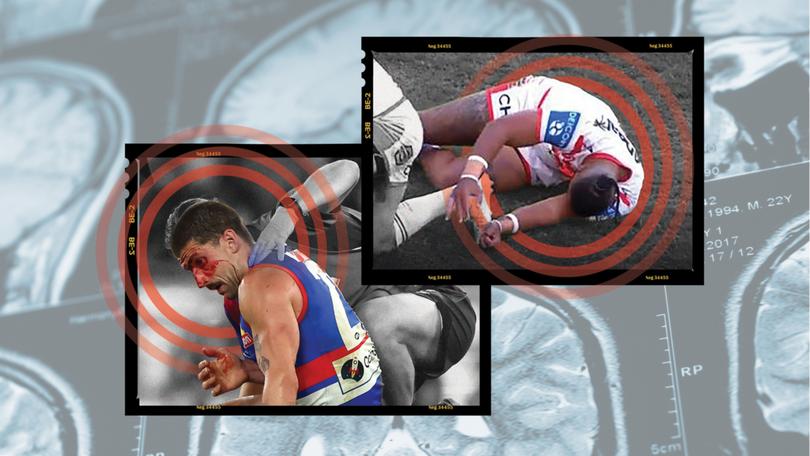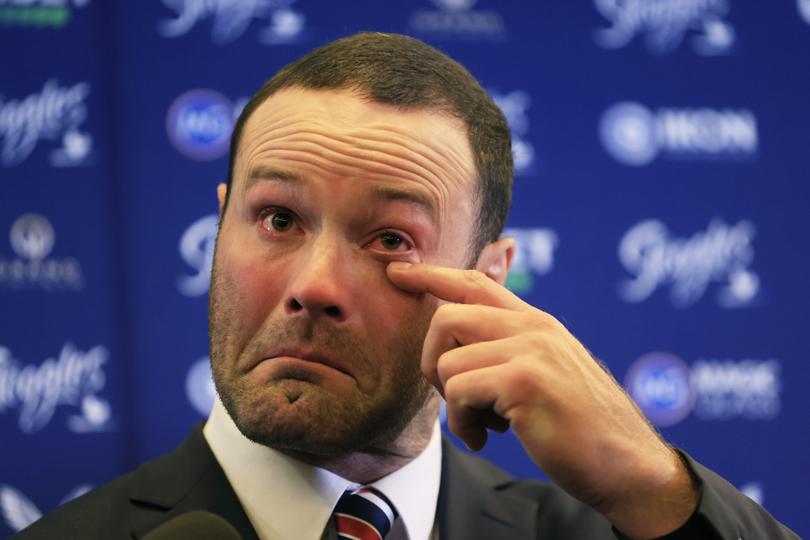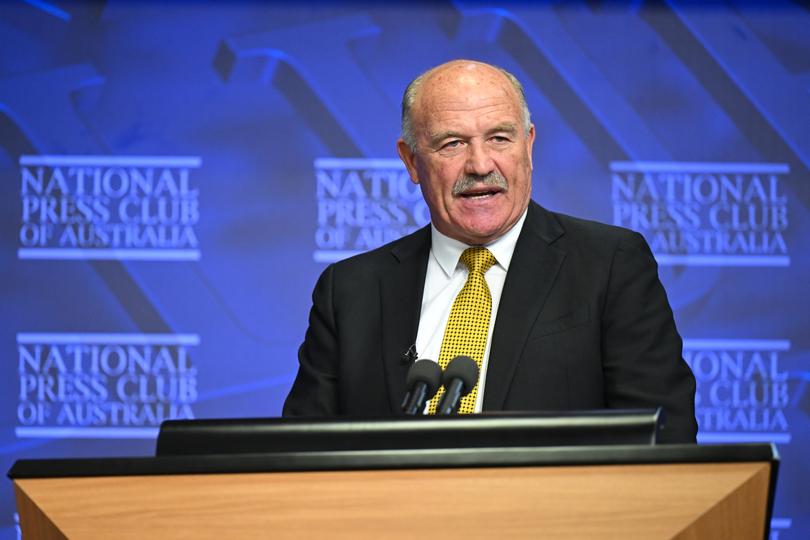CONCUSSION CRISIS: How the NRL and AFL must grapple with the hidden threat of head knocks

Tom Liberatore has become the latest, bloodied, face of the concussion crisis griping the two biggest sport codes in the country.
His career hangs in the balance after he was concussed for the second time in weeks and was escorted off the field on Sunday sporting a nasty cut.
Chronic traumatic encephalopathy was a phrase rarely uttered in sporting circles a decade ago but it is now a consideration in every game, with players undergoing on-field and off-field health assessments to determine if they should keep playing after taking a knock. More times than not, they stay off the field.
Sign up to The Nightly's newsletters.
Get the first look at the digital newspaper, curated daily stories and breaking headlines delivered to your inbox.
By continuing you agree to our Terms and Privacy Policy.But despite CTE being a hot topic, the main cause of the condition isn’t being as widely discussed.
Education around concussions and brain injury has increased dramatically over the past five years.
But there’s something very important that’s not being picked up by those involved in the football codes.
The narrative is that CTE is about repeated heavy concussions — that’s the reason why players say they are retiring early. While that is true to a degree, it’s not the biggest risk factor in an athlete suffering CTE in the future.
Concussions will be very hard to stop in contact sports unless there’ are big changes in the way football codes are played.
Dr Rowena Mobbs is the principal neurologist at Harbour Neurology Group where she leads a team of specialists for integrated neurological care.
Dr Mobbs, who is also the founder and director of the Australian CTE Biobank, explained that it is the innocuous head knocks that don’t hurt players that are concerning medical experts.
“The only cause of CTE is repetitive traumatic brain injury,” Dr Mobbs said. “The major risk of CTE is comprised of sub-concussions, or those hits enough to injure the brain without symptoms generated.
“Most people interpret that concussions cause CTE and although this could be a factor in the total force experienced, the major risk is thought to be thousands of sub-concussions.”
It’s the sub-concussions players don’t realise they’ve had that are playing a huge factor in an athlete’s future CTE risk.
The football codes are taking concussion seriously, but it’s impossible to treat the sub-concussions because they go unnoticed.
AFL great Danny Frawley took his own life in 2019 due to complications of CTE.
But, worryingly, Frawley was only suffering from low-stage CTE. He was in the second stage of the disease.
“There’s four stages of CTE,” Dr Mobbs explained.
“Low CTE is the Stage 1 and 2. High CTE is Stage 3 and 4 and that’s when there’s changes such as loss of brain volume.”
Former Richmond player Shane Tuck also took his own life, in 2020, and the autopsy revealed he had severe CTE.
Tuck had also boxed and was the victim of a shocking knockout loss in one of his five fights.
NEW RULES
Dr Mobbs, one of Australia’s leading neurologists, says there should be further rule changes the football codes if administrators are serious about stopping CTE in its tracks.
She said the footy codes — Australian Rules football, rugby league, rugby union and even soccer — needed more changes to protect players from sub-concussions.
And Dr Mobbs predicted their futures. “We will likely see greater changes in these contact and collision sports towards a more skills-based game,” Dr Mobbs said.
“Changes in these sports are inevitable if we are seriously to consider the safety of our children entering them.
“To continue to focus attention to higher, heavier hits is no longer a reality.”
The problem with that is fans love big hits. People love watching brutality in sport which is why boxing and MMA matches have always attracted huge interest around the world.

Dr Mobbs wants sports to be “balanced with neurological safety”.
“The last thing we want to see is children out of sport but we have to be in a safer sporting environment,” Dr Mobbs said.
“The latest evidence from the US would suggest that at the top echelons of NFL there may be up to 10 per cent (of ex-players) with CTE but that research is ongoing.”
Even soccer isn’t immune to the threat of sub-concussions.
A 2023 study at Columbia University Irving Medical Center linked heading the ball in soccer to a decline in brain structure and function over a two-year period.
“There is enormous worldwide concern for brain injury in general and the potential for soccer heading to cause long-term adverse brain effects in particular,” said Professor Michael Lipton of Columbia University.
“This is the first study to show a change of brain structure over the long-term related to sub-concussive head impacts in soccer.”
BOLD NRL MOVE
Debate has been raging in the NRL about banning the kick-off to avoid what are the heaviest collisions in matches.
The NFL in America has changed its rules to basically end the kick-off to minimise concussions.
It would seem the NRL has been taking the advice of experts such as Dr Mobbs for longer than the public have known. The NRL slipped in a rule change at the start of the season that stated teams wouldn’t be penalised for short drop-outs that go out on the full or don’t go the required 10 metres. It said at the time it would make the game more exciting and less predictable.
But it’s become apparent it was all about reducing long-range kick returns — and therefore the amount of heavy collisions — and putting focus on a skills-based part of the game.
St George Illawarra’s Moses Suli was knocked out in a horror collision on Anzac Day from the opening kick-off but he says he does not want kick-offs banned.
Former premiership-winning Penrith captain Greg Alexander has said he would support banning the kick-off.
Australian and NSW Origin second-rower Liam Martin doesn’t think a current player would be brave enough to publicly support banning kick-offs. And he doesn’t want them banned either. “It’s a part of the game and I don’t think it will ever happen and I don’t think it should,” Martin said.
PLAYER CONCERN
It’s easy to forgive current footballers for not playing much attention to CTE, which can only be identified after death.
It’s an issue that generally won’t potentially affect them for decades after they’re retired.
Right now, it’s about winning premierships and earning the big bucks and it’s hard to walk away from an $800,000-a-year contract. But some players are being forced to retire early due to repeated head knocks and the prospect of future CTE ruining their lives when they’ve still got decades to live.
Dale Finucane was the latest high-profile NRL player to call it quits after seeking medical advice. But he’d already put his body through 251 gruelling first-grade games.

Roosters champion Boyd Cordner retired in 2021 after succumbing to concussion symptoms.
In the AFL former Melbourne Demon Angus Brayshaw and Collingwood Magpie Nathan Murphy both retired this year due to repeated concussions.
Brayshaw was just 28 and had five more years left on his contract. Another high-profile player to retire due to concussion was Paddy McCartin, who was forced out of the game last August.
Paul Seedsman, Mark Adams and Max Lynch also retired last year because of concussion.
In 2019, premiership Western Bulldogs player Liam Picken also had to hang up the boots due to repeated head knocks.
In rugby union, Billy Guyton died of a suspected suicide last year and was the first from his code to be diagnosed with CTE.
Like Frawley, he too was only in stage two of the disease.
Penrith Panthers forward Matt Eisenhuth said all those examples made CTE impossible not to think about.
He said that player welfare had come so far in a short space of time. The days of playing on when concussed are over.
“It was a different era then and there wasn’t as much information out there,” Eisenhuth said.
“As a player, I know a lot more about concussions now than I did when I first came into grade and the younger generation are getting looked after a lot better than I was when I first started playing in the under-20s.
“In a way, it’s good to see players retire early after too many concussions because you need to look after your long-term health.”
In America, the youngest known gridiron player to have CTE was just 17 years old.
Those stories no doubt have an effect on current players.
Martin said he was “not too worried at the moment” and part of that has to do with CTE not being present while playing like a knee injury is for example.
“It’s different (to other injuries) but we’re still all aware of how important the issue is,” Martin said.
“Your brain is the most important part of your body so the last thing we want is to be affected by it (CTE) down the track. The game is doing a pretty good job with all the concussion protocols to look after players.”
FUNDING IS VITAL
Rugby league great Wally Lewis, below, has called on the Federal Government to pour more funding towards brain injury research after revealing he’s likely living with CTE.
Lewis wanted the Federal Government to commit $18 million towards a national pilot program to support people with CTE and to help raise awareness of the condition.

Dr Mobbs said the funding would have profound effects.
“An $18 million injection of funding for CTE would change the game for Australia,” she said.
“In this relatively new field of research we long thought that CTE only affected boxers but we now know that there as many sports involved.
“The scientific challenge is to identify biomarkers for CTE during life.
“Once we can detect CTE in life the doors will be open towards clinical trials to attempt to eventually cure.”
Shortly after the plea from Lewis, the Federal Government announced it will direct more funding into dementia and brain injury research.
Federal Aged Care and Sport Minister Anika Wells said the government would back the 68-year-old sporting great’s call. “As Queenslanders know innately in our blood that bleeds Maroon that Wally Lewis is king, and the king gets it right most of the time, and he’s right about CTE,” Ms Wells said.
“That’s why we’re going to back him and we’re going to have more to say about that in the Budget.”
Funding is the first vital step to finding a cure for CTE, but can the football codes find a way JUto reduce the sub-concussions while keeping the fabric of the games fans love intact?
Lifeline 13 11 14
